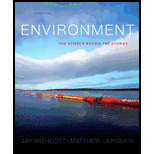
That what renewable and nonrenewable resources have in common and also the way in which they differ and two renewable and two non renewable resources.
Answer to Problem 1TYC
The natural resources should be consumed at sustainable rates in order to prevent their depletion. Both renewable and nonrenewable resources are restored at different rates and thus a meticulous use of resources should be practiced so that these resources are available for the future generations also. Two renewable resources: Sunlight and wind energy Two nonrenewable resources: Minerals and fossil fuels.
Explanation of Solution
There are environmental resources or substances which are required by the living organisms present on Earth for survival. These naturally occurring resources which are present without any action of humans are called natural resources. The natural resources are exploited by humans for economic gain. The natural resources are of two types: Renewable and nonrenewable resources.
Renewable and nonrenewable resources are both natural resources that exist naturally in the environment. They both are required by various living organisms for their survival. They both are exploited by mankind to gain economic profit.
The difference between renewable and nonrenewable resources is:
| Renewable resources | Non renewable resources |
| Renewable natural resources are those resources which can be restored naturally and exist in unlimited amount. | Non renewable resources are those resources which are exhaustible and cannot be restored. |
| Some of these inexhaustible natural resources like sunlight, wind, and air will always be present as their availability and quantity is not affected by humans. But some exhaustible renewable resources like fresh water, soil and timber will be depleted if they are overused. |
Fossil fuels like petroleum and coal are the non renewable resources cannot be recycled are prone to depletion. |
| They have rapid recovery rate and thus are not prone to depletion easily as they can be restored easily. | The rate of formation of non renewable resources is very slow as compared to the rate of their consumption that leads to their depletion. |
Want to see more full solutions like this?
Chapter 1 Solutions
Environment: The Science Behind the Stories (5th Edition)
 Applications and Investigations in Earth Science ...Earth ScienceISBN:9780134746241Author:Edward J. Tarbuck, Frederick K. Lutgens, Dennis G. TasaPublisher:PEARSON
Applications and Investigations in Earth Science ...Earth ScienceISBN:9780134746241Author:Edward J. Tarbuck, Frederick K. Lutgens, Dennis G. TasaPublisher:PEARSON Exercises for Weather & Climate (9th Edition)Earth ScienceISBN:9780134041360Author:Greg CarbonePublisher:PEARSON
Exercises for Weather & Climate (9th Edition)Earth ScienceISBN:9780134041360Author:Greg CarbonePublisher:PEARSON Environmental ScienceEarth ScienceISBN:9781260153125Author:William P Cunningham Prof., Mary Ann Cunningham ProfessorPublisher:McGraw-Hill Education
Environmental ScienceEarth ScienceISBN:9781260153125Author:William P Cunningham Prof., Mary Ann Cunningham ProfessorPublisher:McGraw-Hill Education Earth Science (15th Edition)Earth ScienceISBN:9780134543536Author:Edward J. Tarbuck, Frederick K. Lutgens, Dennis G. TasaPublisher:PEARSON
Earth Science (15th Edition)Earth ScienceISBN:9780134543536Author:Edward J. Tarbuck, Frederick K. Lutgens, Dennis G. TasaPublisher:PEARSON Environmental Science (MindTap Course List)Earth ScienceISBN:9781337569613Author:G. Tyler Miller, Scott SpoolmanPublisher:Cengage Learning
Environmental Science (MindTap Course List)Earth ScienceISBN:9781337569613Author:G. Tyler Miller, Scott SpoolmanPublisher:Cengage Learning Physical GeologyEarth ScienceISBN:9781259916823Author:Plummer, Charles C., CARLSON, Diane H., Hammersley, LisaPublisher:Mcgraw-hill Education,
Physical GeologyEarth ScienceISBN:9781259916823Author:Plummer, Charles C., CARLSON, Diane H., Hammersley, LisaPublisher:Mcgraw-hill Education,





